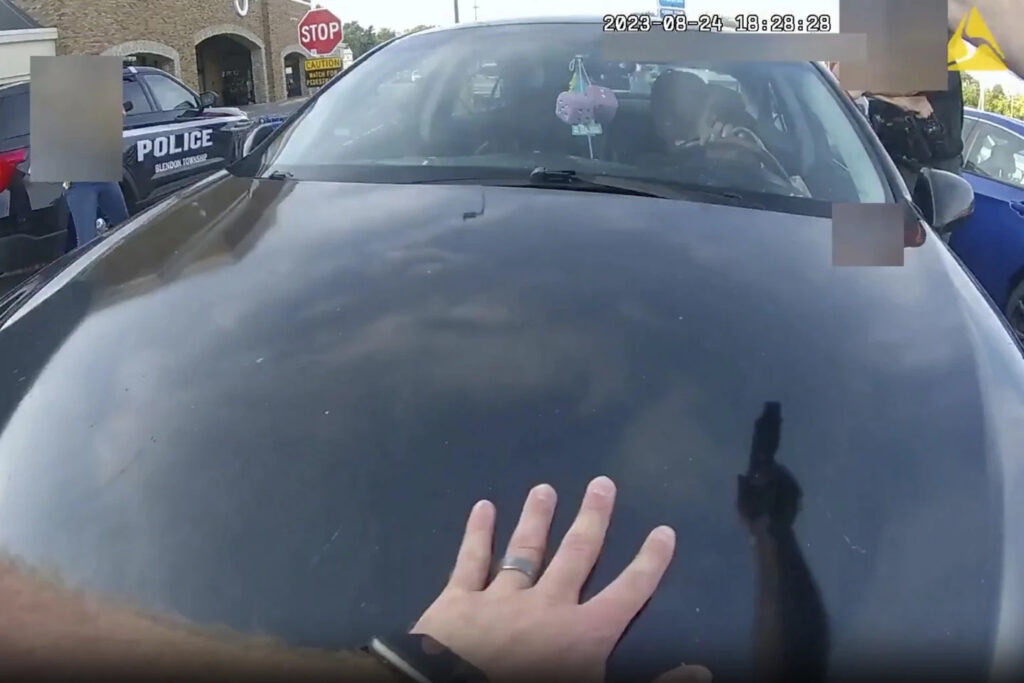Body camera video of the fatal police shooting of Ta’Kiya Young, a 21-year-old pregnant mother in a suburb of Columbus, Ohio, has raised questions about how an allegation of shoplifting led to a bullet being fired through her windshield.
It was unclear Saturday whether the Blendon Township Police Department has adopted a use-of-force continuum policy, which would outline measures that must be exhausted before lethal force can be used.
The video of the Aug. 24 shooting, released Friday, shows Young in her car in a parking space as a police officer orders her to exit the vehicle. A second officer is seen drawing his firearm and stepping in front of the car, despite a department policy advising officers to get out of the way of an approaching vehicle instead of firing their weapon.
“Are you going to shoot me?” Young asks, seconds before she turns the steering wheel to the right and the car moves toward the second officer. The officer fires through the windshield and Young’s sedan drifts into the grocery store’s brick wall.
Lawyers for Young’s family say the video is devastating and have called for the officer who shot her to be fired and criminally charged. Blendon police officials have refused to name either of the officers involved.
Here is a look at law enforcement policies on moving vehicles:
WHAT ABOUT FIRING AT MOVING CARS?
The New York City Police Department was among the first to bar officers from firing at or from moving vehicles after a 1972 shooting that killed a 10-year-old passenger in a stolen car led to protests.
Researchers in the late 1970s and early 1980s found the policy, along with a handful of other use-of-force restrictions, led to a decline in bystanders being shot and suspects dying in police shootings.
Other law enforcement agencies have over the decades followed NYPD’s lead, and industry organizations such as the Police Executive Research Forum and the International Association of Chiefs of Police have recommended the restrictions, saying shooting in such circumstances creates an unacceptable risk to bystanders from stray gunfire or the driver losing control of the vehicle if shot.
The Blendon Township department’s policy states: “An officer should only discharge a firearm at a moving vehicle or its occupants when the officer reasonably believes there are no other reasonable means available to avert the imminent threat of the vehicle, or if deadly force other than the vehicle is directed at the officer or others.”
But as of June only 32 police departments in the 100 largest U.S. cities had some form of restriction on firing at moving vehicles, according to Campaign Zero, an advocacy group of academics, activists and others seeking to end police brutality.
HOW ARE SUCH POLICIES INTERPRETED AND ENFORCED?
John P. Gross of the University of Wisconsin Law School, who has written about the challenges of ending police shooting at moving vehicles, said individual department policies sometimes include exceptions if a suspect is firing a weapon or if the car is being used as a weapon against an officer, though many restrictions specifically say other weapons must be present.
Prosecutors and internal police investigators often focus on the moment of use of force, but a broader view is necessary, he said. For example if an officer already has a license plate number, that may be a reason not to use force to stop a vehicle, since “most of us are findable.”
“If you are pursuing someone accused of a homicide and who has shot at officers in the past, that’s a different situation than somebody who might have shoplifted $50 worth of items,” Gross said. “That context should be part of this.”
Departments often don’t enforce the policies with meaningful discipline in part because of the strength of police unions, Gross said. In Blendon Township, union officials have said Young’s car became a weapon the moment it began moving.
SHOULD OFFICERS PURPOSELY MOVE IN FRONT OF VEHICLES?
Many department policies advise officers to move out of the way. But in the Ohio video, an officer is seen drawing his firearm and putting himself in the path of Young’s parked car, which Gross called “bad tactics.”
“And oftentimes bad tactics translates to needing to use more force than was necessary,” Gross said. “The officer shouldn’t put himself in front of the car. He can’t stop the car with his body.”
Edward Obayashi, a national use-of-force expert and attorney who specializes in vehicle-related police shootings, agreed and said the officer went against his training.
“The best practice in these matters nationwide is that you do not put yourself in a position of danger,” Obayashi said. “There was no urgent need for him to position himself the way he did.”
Gross also questioned why the officer drew his firearm when the issue at hand was a shoplifting allegation. He urged changes to police training.
“They are taught that if someone is resisting even verbally, that person is going to fight or flee,” Gross said. “That just ties resistance to a threat. Training teaches officers that there is danger around every corner and threats are everywhere.”
Source : apnews

